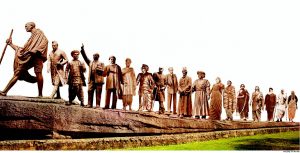History Of India [ Glorious Past of India ]
History of India covers thousands of periods and dynasties. If we arrange these dynasties in a chronological order, we have to go back to the Stone Age which is known as the beginning.
Stone Age
Remains of stone tools and a skull depict the presence of an early species of man (Homo erectus). Archeologists believe that they started living in India about 500,000 years ago. This is known as Paleolithic era.
Next comes the Mesolithic era which is also a part of the Stone Age. Modern humans (Homo sapiens) started living in India 12,000 year ago.
Neolithic agriculture sprang up in the Indus Valley region around 7000 years ago, in the lower Gangetic valley around 5000 years ago and also into Malwa around 3800 years ago.
Chalcolithic era covered the regions of modern Maharashtra except the part of vidarbha and the coastal region of Konkan. This era marked the end of the Stone Age.
Bronze Age
Next comes the Bronze Age which established 5300 years ago with the early Indus Valley Civilization (including cities like Harappa, Mohenjo-Daro, Lothal , Kalibanga ). It was situated on the Indus River and its tributaries which lengthen to the Ghaggar-Hakra River valley. The initial cities in the subcontinent were in the Indus Valley Civilization. It is one of the world’s earliest urban civilizations. About 3700 years ago, most of the cities were deserted. However, the Indus Valley Civilization did not fade away suddenly. Few parts of the Indus Civilization may have continued to exist in the smaller villages and secluded farms.

Vedic Civilization of History of India
The Vedic Civilization gave birth to the Vedas which were the oldest teachings of India and were mainly oral until the 5th century. According the RigVeda the entire region in which the Aryans were first settled in India which was called as the Land of 7 Rivers or Sapta Sindhawa .The other three Vedas are SamVeda, YajurVeda and Atharva Veda. The Vedas have verses in honor of gods. Vedas are the precious gift from history of india.
Around the 5th century BC, north-western parts of India faced invasion by the Achaemenid Empire and by the Greeks of Alexander the Great. A Persian way of philosophy, management and standard of living came to India. This was known as the Persian and Greek Invasion.
Magadha Empire
The Magadha Empire formed one of the sixteen kingdoms in ancient India. Magadha played an imperative role in the expansion of Jainism and Buddhism. Two of India’s supreme empires, the Maurya Empire and the Gupta Empire, originated from Magadha.
The early middle kingdoms in history of india included- Satavahana Empire, Western Kshatrapas, Indo-Scythians, Gupta dynasty and Hun invasion.
Satavahana Empire came to power from about 230 BC. They were also known as Andhras. For about 450 years, many Satavahanas kings ruled the majority parts of the southern and central India.
Western Kshatrapas ruled for about 350 years, from the years 35-405, Saka kings ruled India. They ruled the western and central parts of India. There were 27 independent rulers, communally known as the Kshatrapas.
Indo-Scythians came to India from Siberia passing through numerous places like Bactria,Sogdiana, Kashmir and Arachosia . They conquered the Indo-Greek rulers of India, and ruled India from Gandhara to Mathura.
The Gupta dynasty
The Gupta dynasty reigned from around 320 to 550 AD. The Gupta Empire covered most of North-central India. Gupta society was ordered in harmony with Hindu beliefs.
By the middle of the fifth century, a cluster of people known as Huns had settled in Afghanistan. Skandagupta, an emperor of the Gupta dynasty battled back and kept them away for some years. At last the Huns won. With this the Gupta dynasty came to an end. This was the Huns invasion.
Late Middle kingdoms of India
Late Middle kingdoms of India cover a period commencing from the 6th-7th century. After the fall down of the Gupta Empire, it was Harsha of Kanauj who united the northern parts of India in a single realm.
Then the Pratihara kings came into power in Rajasthan and some further parts of northern India from the 6th century to the 11th century. The Palas ruled the eastern part of India.
In the 6th century numerous Rajput kingdoms came into being in Rajasthan. Some of these kingdoms continue to endure for hundreds of years during special phase of the history of India.
Islamic Sultanate Period
Islam spread across the Indian subcontinent over a period of 500 years and was called the Islamic Sultanate period. During this time, the two systems—the prevailing Hindu and Muslim—blended and left long lasting cultural influences on each other.
Slave dynasty was started by Qutub ud din Aibak. He was the one who started the first architectural monument of the slave dynasty or rather the first architectural work of Muslims in India which was Qutub Minar which was completed in during the Delhi Sultanate period.
Sikhism
Guru Nanak founded Sikhism and his supporters were called Sikhs. The supremacy of Sikhs continued to increase in the northwestern part of India. The Sikhs became rulers of a huge part of the northwestern India. This is called the Sikh Kingdom or Empire.
Durrani Empire
A person named Ahmed Shah Durrani ruled some parts of northwestern India. Historians have named his rule as the Durrani Empire. He took many valuable things from India. This included the famous diamond named Kohinoor.
Colonial period
Colonial period means the period during which Western countries ruled India. In the 1600’s the British East India Company began a very profitable trading empire in India this commenced the Company Raj.
India won its independence, and became a free country on August 15, 1947 and Now India is Known as Incredible India .
This was the basic information about the Glorious Indian history and Glorious Past of India and I hope it helped you to know more about your country.